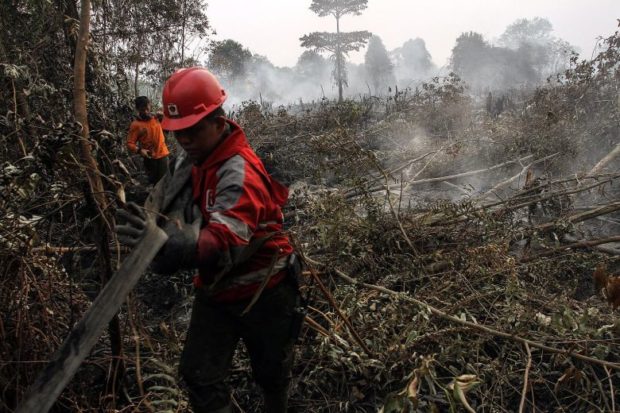Haze in region gets worse as hot spots rise in Malaysia, Indonesia

Indonesian firemen inspecting land in Kampar, Riau province, on Tuesday. More than a thousand hot spots have been spotted in Sumatra and Kalimantan. Malaysia saw its air quality worsen dramatically, with the air pollutant index in Rompin, Pahang, climbing to 232, in the “very unhealthy” range. PHOTO: EPA-EFE via The Straits Times
JAKARTA — Smoke-filled skies have forced the closure of thousands of schools in Indonesia and Malaysia, and raised tensions between the neighbors over who is to blame for the haze choking the region.
Meanwhile, the number of hot spots continues to rise, worsening the air quality in large parts of both countries.
Indonesia’s disaster management agency said that more than 3,600 fires have been detected on Sumatra and Borneo islands, enveloping six provinces with a combined population of more than 23 million in haze and bad air, wire agencies reported.
“The Indonesian government is working systematically to tackle the issue as best as it can. Not all the haze comes from Indonesia,” said Indonesia’s Environment and Forestry Minister Siti Nurbaya Bakar, indicating that Malaysia must accept its share of the blame for forest fires.
Yesterday, the Indonesian authorities were resorting to water bombing to put out the fires that have razed almost 1,620 sq km of land in the provinces of Riau, Jambi, South Sumatra, West Kalimantan, Central Kalimantan and South Kalimantan.
Article continues after this advertisementHelicopters were pouring millions of litres of water on forests in efforts to douse the flames.
Article continues after this advertisementSome 9,000 personnel were deployed to put out the fires but air pollution levels still hit hazardous levels in Pekanbaru, the provincial capital of Riau, where thousands of schools have been shuttered since Tuesday.
Meanwhile, eight of Malaysia’s 13 states have seen their air quality worsen dramatically, with the air pollutant index in Rompin, Pahang, climbing to 232 – a level that sits in the “very unhealthy” range.
Malaysia’s national disaster agency has sent half a million masks to Sarawak, while a ban has been imposed on open burning.
Malaysia remains convinced that its neighbour is to blame for the poor air blowing its way.
Malaysia’s Minister of Energy, Science, Technology, Environment and Climate Change Yeo Bee Yin pointed to the fires in Sumatra and Kalimantan as the cause of the haze blanketing her country.
The Malaysian government will “send assistance to Indonesia if they accept the offer”, she added.
More than a thousand hot spots have been spotted in Sumatra and Kalimantan.
But Indonesia said it was not the only country at fault. Satellite data last week showed a marked increase in hot spots in several parts of Asean, said the Indonesian Environment and Forestry Ministry.
“This increase not only occurred in Indonesia, but also mainly in the Malaysian peninsula and parts of Vietnam, triggering an increase in haze that has spread locally,” the ministry added.
Ms Siti Nurbaya charged that Malaysia has not been open about its own forest fires.
“The haze that entered Malaysia – that entered Kuala Lumpur – comes from Sarawak and from the Malaysian peninsula, and perhaps partially West Kalimantan,” she said yesterday. “They need to explain this objectively.”
Jakarta plans to ask Malaysia to “correct their data”.
Despite Indonesia’s protests, the Asean Specialized Meteorological Center has flagged Sumatra and Kalimantan as sources of haze engulfing the region.
Smoke from hot spots in these areas, which have been shrouded in moderate to dense haze, has been blown by prevailing winds to Singapore and Malaysia, said the Singapore-based centre.
And it will be a long fight, with the dry season expected to last till next month.
“The end of the drought period is still a long way away, so we need to work hard to put out forest fires or, at the very least, ensure they do not grow bigger,” Dr Agus Wibowo, acting spokesman for Indonesia’s disaster management agency, told The Straits Times.
Even so, Indonesia will tackle the issue alone for now, he stressed.
“We can handle it, so there’s no need for outside help at this moment,” he said.